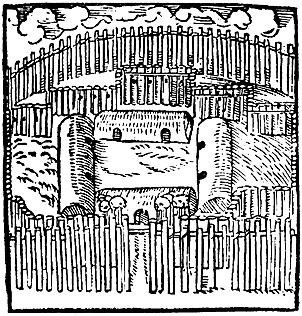Athena Review Image Archive ™
Tupinamba palisaded village in southeast Brazil

Tupinamba palisaded village with skulls on gate (Staden 1557).
Hans
Staden, a German soldier captured by Tupinamba warriors in 1552, knew
the Tupi language and was able to observe many aspects of this now
extinct culture, recorded after his escape his book Hans Staden: The True History of his Captivity, published in 1557.
Part
2 of the book contains Staden's descriptions of Tupinamba villages,
including their layout of longhouse settlements grouped within
palisaded clearings, as well as manioc preparation, pottery
manufacture, marriage and political customs, and the practice of
Tupinamba cannibalism. Related customs included placing enemy skulls on
the village gateposts, as shown in this image.
Staden's
written account with its illustrations remains a primary source on the
16th century Tupinamba culture, which dominated large portions of
southeastern Brazil, and whose language was used for trading as far
away as the Andes at the time of initial European contact.
Copyright © 1996-2019 Rust Family Foundation (All Rights Reserved).